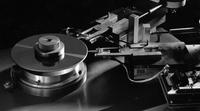Founding Calit2 Layer Leader at UCSD Elected to National Academy of Engineering
San Diego, CA, February 8, 2008 -- UC San Diego Jacobs School of Engineering professor Paul Siegel – a leading authority on coding for hard disk magnetic recording systems – has been elected to the National Academy of Engineering "for the invention and development of advanced coding techniques for digital recording systems."
|
Siegel is an electrical engineering professor and the director of UCSD’s Center for Magnetic Recording Research (CMRR) – a collaboration between the campus, companies in the magnetic recording industry and government agencies. The CMRR mission is to advance the state-of-the-art in magnetic storage, and to produce highly trained graduate students and postdoctoral professionals.
Siegel is also an academic participant in the UCSD division of Calit2, and led its networked infrastructure "layer" during the institute's formative years. As an information theorist, Siegel is also a faculty member of Calit2's Information Theory and Applications Center (ITA), and has been a co-principal investigator on Calit2 sponsored-research projects, including those on CDMA systems and space-time processing for wireless (funded by Ericsson and the UC Discovery Grant program).
In the 1980s and early 1990s, Siegel was part of an IBM team that helped to revolutionize the hard disk industry through advances in signal processing. Siegel’s work on signal processing systems has increased the reliability of information retrieval from hard disk drives. His patents and publications provided part of the framework for the introduction of a signal processing approach called “coded partial response, maximum likelihood” (PRML) which is used in every disk drive today.
PRML, along with the introduction of advanced heads and disks, enabled the extremely rapid growth in capacity of magnetic hard disk drives. A one gigabyte hard disk drive in 1984 cost approximately $50,000 and was the size of a small washing machine. Today, mp3 players like iPods contain drives with 30 times this capacity and these are small drives by today’s standards.
For information to be stored on a hard disk, electronic signals carrying the data first travel down a wire to one of the disk’s writing heads. To record this information, the write heads leak flux which results in information stored on the disk.
Retrieval of this stored information requires a read head flying very close to the disk to read the information as pulses. These pulses must be converted back to electronic signals in an ultra reliable way – and this is where Siegel’s work enters the picture.
Hard disk storage capacity is increased by packing more bits per unit of surface area. This increased density causes interference among read pulses – a phenomenon known as intersymbol interference or ISI – and makes reliable retrieval of data from hard disks more challenging.
One way to deal with ISI would be to narrow the pulses to reduce interference among pulses, but this increases the noise. Another approach could be to increase the space between bits on the hard disk thus increasing the inter-pulse distance – but that is counterproductive to the goal of increasing a disk’s storage capacity.
|
With this work, Siegel demonstrated that ISI complications to the read process can be mitigated with signal processing. He and his collaborators showed that you can control this interference and then use the Veterbi algorithm to unscramble the PRML.
“Paul worked on finding codes that give better performance when the PRML is unscrambled by the Viterbi detector,” said Jack Keil Wolf, the Stephen O. Rice Professor of Magnetics at the Department of Electrical and Computer Engineering at the Jacobs School.
The Viterbi algorithm and detector are named after their inventor, Andrew Viterbi, a co-founder of both Linkabit Corporation and Qualcomm Inc. In the 1970s and 1980s, Viterbi spent time as a UCSD professor while working at Linkabit and later at Qualcomm. He is now an Emeritus Professor at UCSD.
“Paul’s early work at IBM was on both modulation codes and error correction codes. He showed that you want to prevent certain sequences from being written on the disk, even if those sequences correspond to the data. For example, if you write all zeros, nothing will come off the drive when you read it and this means you lose the timing, and you want to avoid that,” said Wolf who is also a member of the NAE and leader of the Signal Processing Group within UCSD’s CMRR.
More recently, Dr. Siegel introduced iterative techniques for applications in storage. Several manufacturers are now developing read-write chips which utilize this principle. At CMRR, Siegel oversees research activities on a wide range of issues related to digital data storage and communications. He leads the Signal Transmission and Recording Group (STAR) at UCSD, and participates in UCSD’s Center for Wireless Communications(CWC).
Related Links
Signal Transmission and Recording Group
NAE Press Release
Center for Magnetic Recording Research
Media Contacts
Media Contact: Daniel Kane, 858-534-3262, dbkane@ucsd.edu


